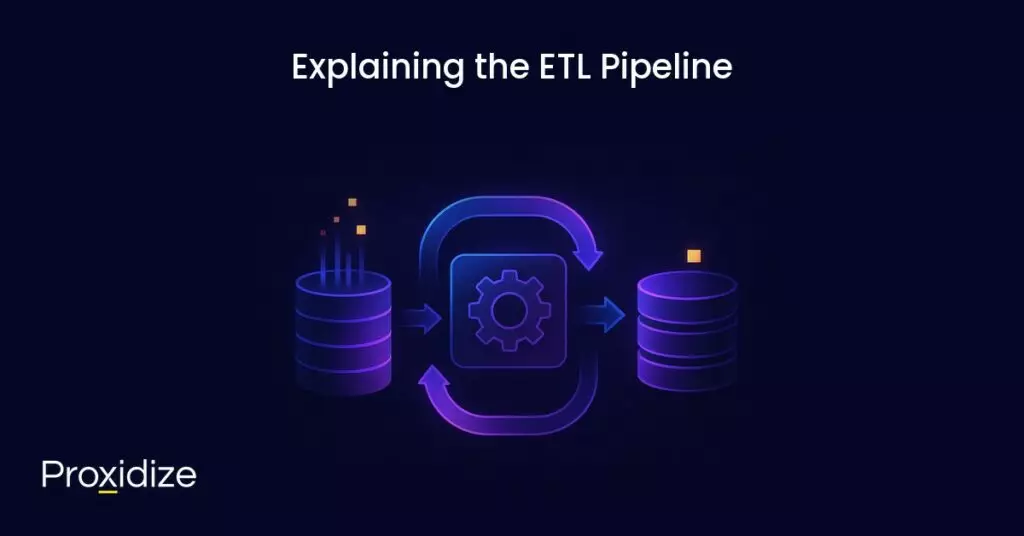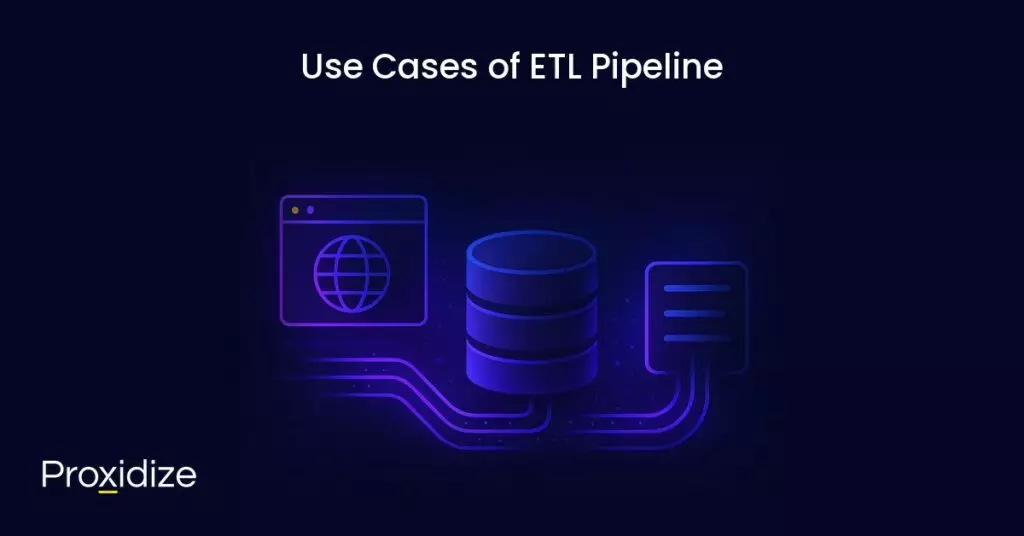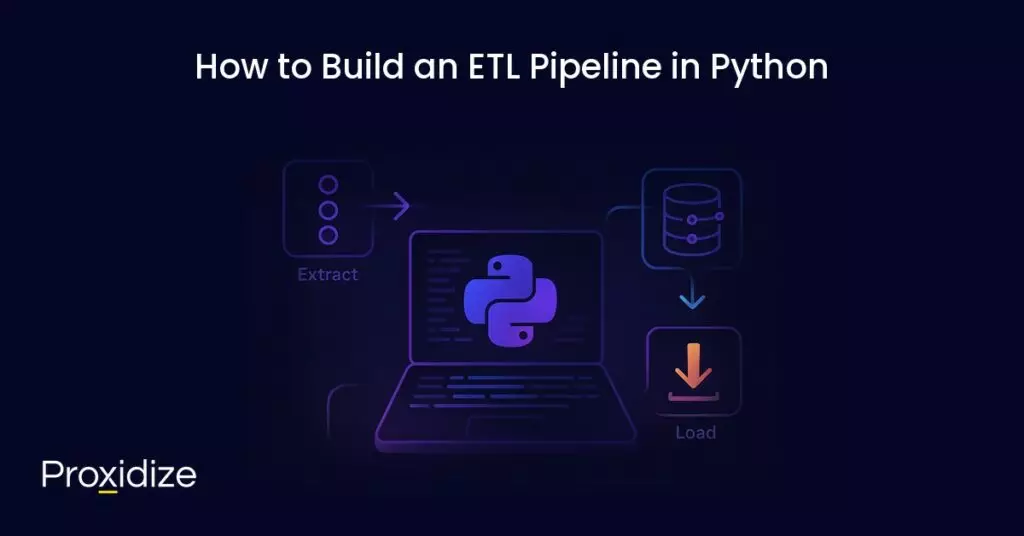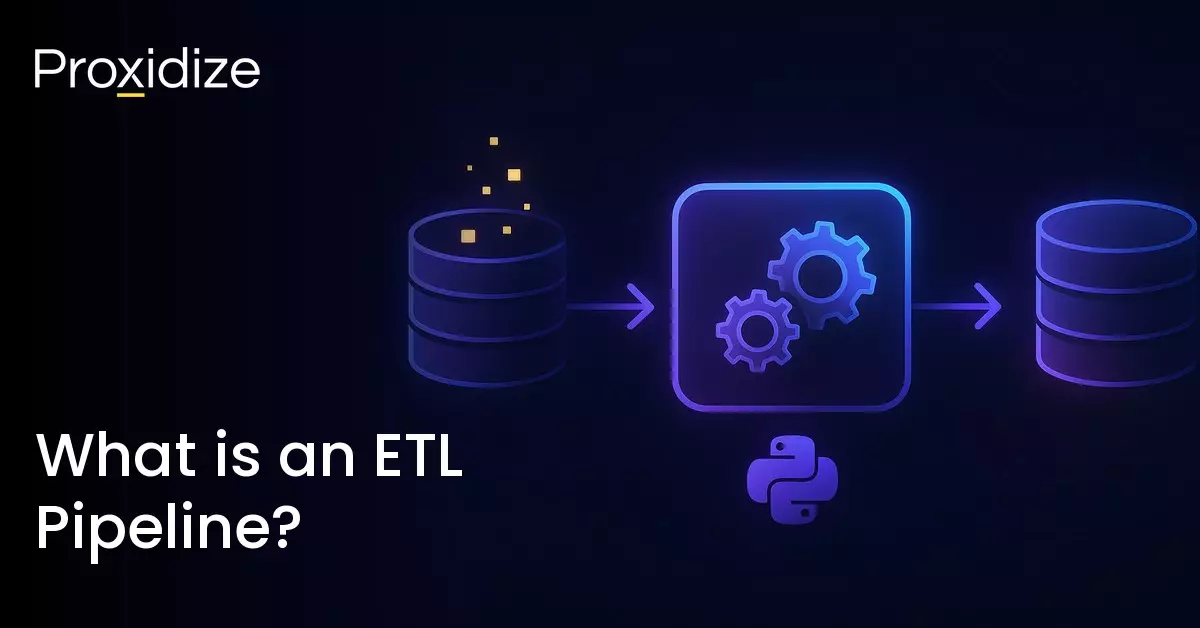An ETL pipeline is a data processing tool used to extract, transform, and load data from various sources into an organized system. It begins with extracting raw data, transforming it into a cleaner format, and then loading it into a database.
ETL pipelines are necessary for ensuring data quality, improving data consistency, and enabling efficient analysis and reporting. This article aims to explain what the ETL pipeline is, how it differs from a data pipeline, its use cases, and introduce a way to build your very own ETL pipeline in Python.

Explaining the ETL Pipeline
An ETL pipeline is an ordered set of processes used to extract data from one or multiple sources before transforming it and loading it into a target repository. These pipelines are reusable for one-off batch, automated recurring, or streaming data integrations. The data can be used for reporting, analysis, and delivery insights. By using web automation, ETL pipelines can reduce manual workload and minimize errors that happen during data handling. The three parts that make up the ETL pipeline are extract, transform, and load. Let us explore each part in detail.
Extract
The extract process involves pulling data from a source such as an SQL or NoSQL database, an XML file, or a cloud platform holding data such as marketing tools, CRM systems, or transactional systems. During this process, validation rules are applied. They test whether the data meets the requirements of its destination. If the data fails validation, then it is rejected and does not move on to the next step.
There are two standard extraction methods: Incremental and Full Extraction. Increment extraction reduces load on the system as only relevant data is extracted. A full extraction is when the data comes from the sources without committing any changes to the logic or conditions within the source system.
High-quality scraping and automation starts with high-quality mobile proxies
Transform
The transform process will convert the format or structure of the data set to match the target system. Here, data is processed to make its values and structures fit consistently with the intended use case. The goal is to make all data fit within the uniform schema before it moves to the final step. Transformations can include aggregators, data masking, expression, joiner, filter, lookup, rank, router, union, XML, Normalizer, H2R, just to name a few. This can help normalize, standardize, and filter data, making it easier for consumption for analytics when it comes to marketing and other business functions. An important step in the transformation stage is to diagnose and repair any data issues, since after the data is moved to the load stage, doing so becomes more complex and tedious.
Load
Finally, the load process will place the data set into the target system. This can include a database, data warehouses, or an application such as a CRM platform, data lake, or data lakehouse. Once the data has been loaded, the process is complete. Many organizations regularly perform the process in order to keep their data warehouse updated.
ETL vs Data Pipeline
You may have come across the term “data pipeline” and assumed it was a similar thing to an ETL pipeline. While it’s safe to assume they are the same thing, an ETL pipeline is actually part of a data pipeline. A data pipeline is the umbrella term for the broad set of all processes where data is moved. An ETL pipeline falls under that umbrella as a specific type of data pipeline.
Data Pipeline: They do not transform the data per se; they can transform the data after a load through ETL, or they can keep the data as is. They also do not finish after loading data. Modern data pipelines stream data so their load process can enable real-time reporting or can initiate processes in other systems. They similarly do not run in batches, which allows the data to be continuously updated and supports real-time analytics and reporting.
ETL Pipeline: They transform the data before loading it into the system and move data to the target system in batches on a regular schedule. The ETL pipeline is very specific about what it does with data and how it structures it. The specific aspect of the ETL that differentiates it from data is a sequence of tasks that clean, standardize, and enhance the data to make it suitable for analysis and reporting. This is crucial in maintaining data quality when amalgamating information from origins such as projects involved in web scraping.

Use Cases of ETL Pipeline
When you convert raw data into a target system, ETL pipelines will allow for systematic and accurate analysis. From data migration to faster insights, pipelines are vital for data-driven organizations. They save teams time and effort by eliminating errors, bottlenecks, and latency for smoother flows of data from one system to another. Here are some other use cases for pipelines:
- Enable data migration from a legacy system to a new repository.
- Centralize all data sources to obtain a consolidated version of the data.
- Enrich data in one system with data from another, such as a marketing automation platform.
- Provide stable datasets for data analytics tools to quickly access a single pre-defined analytic.
- Comply with GDPR, HIPAA, and CCPA standards as users can omit any sensitive data before loading it into the system.
ETL pipelines can come in handy when it comes to web scraping. Gathering a large amount of data, especially if the website’s structure is not traditional, will lead to messy and unorganized data. By using a pipeline, you can have more structured data, saving you countless hours trying to remove any unneeded or faulty data.

How to Build an ETL Pipeline in Python
Building your very own ETL pipeline requires a step-by-step approach to ensure it is created efficiently and effectively. The approach you take when building one will depend on the method of ETL you use. We will walk through how to build a standard pipeline using Python.
Using Python to build a pipeline will provide flexibility and customization so you can tailor the process to your specific needs by modifying the ETL script. This is suitable if you have a team with strong Python programming skills, need greater control over your data sources, or regularly find yourself dealing with complex data transformations.
Step 1: Setting Up Your Environment
Make sure you have Python setup with all the necessary libraries before you start doing anything else. Essential libraries include Requests, BeautifulSoup for parsing HTML, Pandas for manipulating data, and SQLAlchemy for interacting with databases.
Step 2: Extracting Data
The extraction phase involves gathering data from your sources. For web scraping, you will typically be using the Requests library to make HTTP requests to the target website and BeautifulSoup to parse the HTML content. If your data is accessible through an API, the Requests library can be used to handle API requests. When dealing with databases, SQLAlchemy or PyODBC will facilitate data extraction directly. When scraping, always keep in mind the importance of using a proxy server (ideally mobile proxies for strict websites) so your scraping remains undetected and uninterrupted.
Step 3: Transforming Data
During the transformation phase, data will be processed to prepare it for analysis. Pandas will provide a variety of features to manipulate data effectively. Use this script to handle that process:
import pandas as pd
def transform(raw_data):
# Convert raw HTML data to a structured format, e.g., DataFrame
data = pd.DataFrame(raw_data, columns=['Column1', 'Column2'])
# Perform cleaning operations such as removing duplicates, filling missing values, etc.
data_cleaned = data.drop_duplicates().fillna(value="N/A")
return data_cleanedThis step may involve complex logic, depending on the quality of the source data and the requirements of the target schema.
Step 4: Loading Data
After your data has been converted, the next step is to transfer it to a location. When dealing with databases, SQLAlchemy will simplify many of the tasks related to database operations.
from sqlalchemy import create_engine
def load(data_frame, database_uri, table_name):
engine = create_engine(database_uri)
data_frame.to_sql(table_name, engine, index=False, if_exists='append')This step may involve considering performance and data integrity, like batch loading or transaction management, to make sure data is loaded efficiently and correctly.
Step 5: Orchestrating the Pipeline
Setting up the pipeline includes arranging a schedule to automate running your ETL tasks. ETL pipeline tools like Apache Airflow or Prefect can be used to outline workflows, schedule tasks, and keep track of the pipeline’s efficiency.
Here are a few extra points to keep in mind when building your pipeline:
Design ETL pipelines for scalability to ensure they can handle growing data volumes and complexity without losing performance. Scalable pipelines will integrate flexible resource allocation, parallel processing, and distributed computing capability to efficiently process increasing datasets. Include modular architectures that allow easy addition or modification of components. Using cloud-based infrastructure will expand capacity and processing power as needed.
Robust error handling in ETL pipelines is also important for maintaining data flow integrity and reliability. By embedding detailed error detection and correction routines, your pipelines can identify and resolve any issues without disrupting operations. Implement automated testing and validation in your pipelines to guarantee data accuracy and robustness before, during, and after processing.
Conclusion
ETL pipelines are crucial for modern data engineering as they power business intelligence, machine learning, and predictive AI by transforming diverse data source systems like ERP systems and CRM platforms to IoT devices, SaaS applications, and social media platforms into business insights. With ETL pipeline tools like AWS Glue, Azure Data Factory, and cloud-native ETL solutions, you can enforce strong data governance and maintain clear data lineage.
Key Takeaways:
- ETL stands for extract, transform, and load and is a method of organizing disorganized data into an easy-to-understand format.
- There are two methods of data extraction: Incremental and Full Extraction. Incremental will gather only the necessary data, while a full extraction will gather all the data.
- You can use the pipeline to update your old data systems and ensure all the information in your database is accurate and correct.
- Using Python to build your own pipeline allows you to easily customize it to your specifications.
- Consider a cloud-based infrastructure to avoid running out of space if you are working with large datasets.
Whether you are loading into relational databases, data lakes, or modern data warehousing services like Google BigQuery and Amazon Redshift, pipelines will support both batch and real-time ETL. Workflows such as Google Cloud Services, Cloud Composer, and Terraform CLI will simplify cloud data integration, database replication, and change data capture while producing reliable outputs for visualization tools and compliance-ready audit reports. By unifying different data types from transactional records and sensor data to JSON server logs and web reports, ETL pipelines ensure scalable, automated, and efficient data processing systems that drive timely and data-informed decisions.
Frequently Asked Questions
Is SQL an ETL tool?
ETL and SQL are two different concepts serving different purposes in data management. ETL tools extract and load data from structured and unstructured data sources into analytics environments. SQL is a programming language for managing relational databases.
Is ETL the same as an API?
ETL is designed for large volumes of data, while APIs are better for smaller frequent data exchanges. ETL will focus on data transformation, while APIs will often transfer data as is.
What language is used in an ETL pipeline?
Most commonly, an ETL is programmed in Python and SQL to handle the scraping capabilities of Python’s Requests library and SQL to manage the data.
What is the most used ETL tool?
A few of the popular open-source ETL tools include Portable, Apache NiFi, AWS Glue, Airbyte, and Infomatica.




